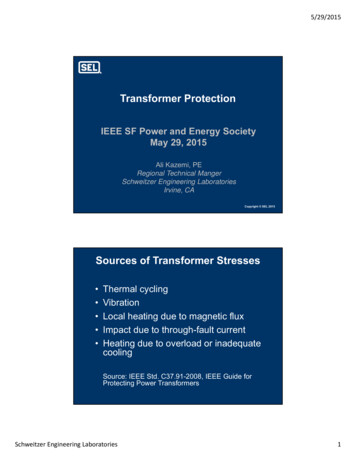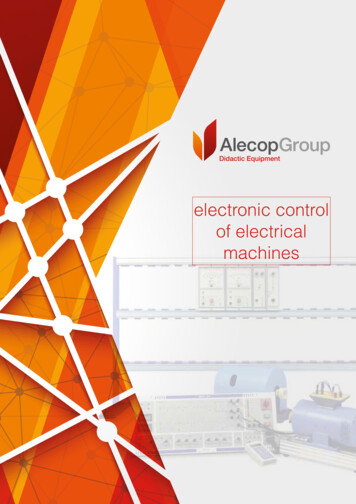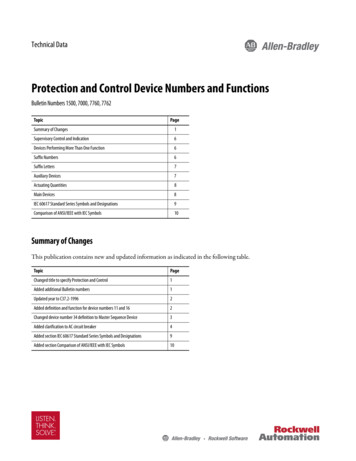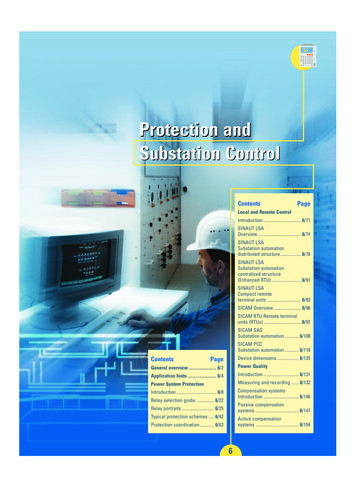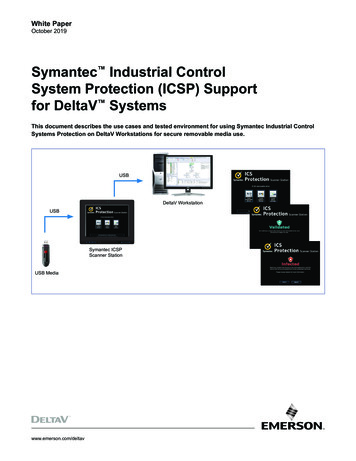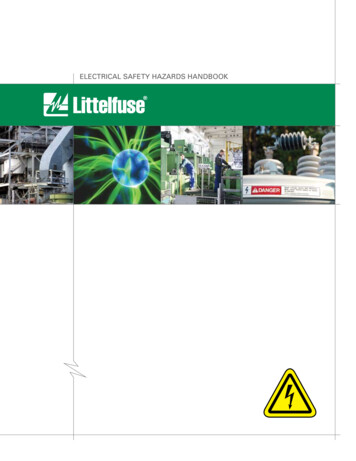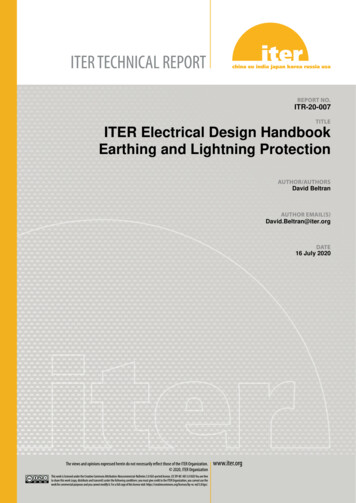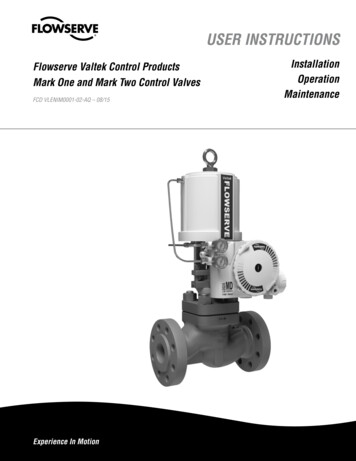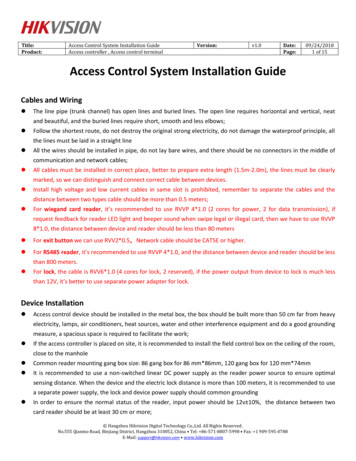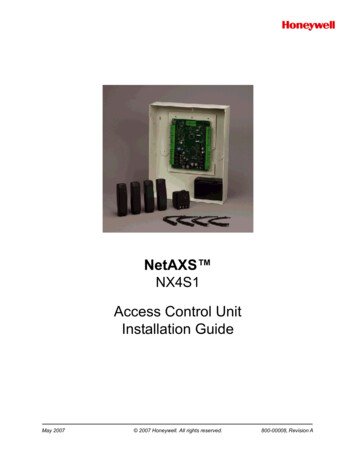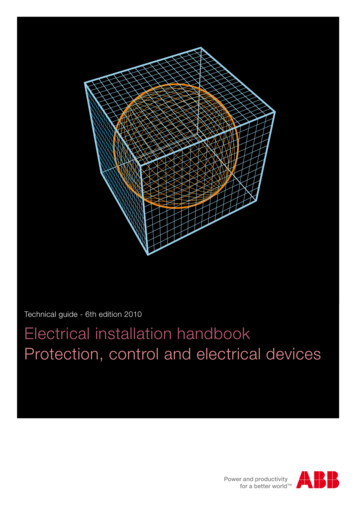
Transcription
Technical guide - 6th edition 2010Electrical installation handbookProtection, control and electrical devices
Electrical installation handbookProtection, control and electrical devicesFirst edition 2003Second edition 2004Third edition 2005Fourth edition 2006Fifth edition 2007Sixth edition 2010Published by ABB SACEvia Baioni, 35 - 24123 Bergamo (Italy)All rights reserved
Electrical installation handbookProtection, control and electrical devicesGeneral aspectsPart 1Protection and control devicesPart 2Electrical devices
General aspectsIndexIntroduction . 61 Standards1.1 General aspects. 71.2 IEC Standards for electrical installation. 19
IntroductionScope and objectivesThe scope of this electrical installation handbook is to provide the designer anduser of electrical plants with a quick reference, immediate-use working tool. Thisis not intended to be a theoretical document, nor a technical catalogue, but, inaddition to the latter, aims to be of help in the correct definition of equipment,in numerous practical installation situations.The dimensioning of an electrical plant requires knowledge of different factorsrelating to, for example, installation utilities, the electrical conductors and othercomponents; this knowledge leads the design engineer to consult numerousdocuments and technical catalogues. This electrical installation handbook, however, aims to supply, in a single document, tables for the quick definition of themain parameters of the components of an electrical plant and for the selectionof the protection devices for a wide range of installations. Some applicationexamples are included to aid comprehension of the selection tables.Electrical installation handbook usersThe electrical installation handbook is a tool which is suitable for all those who areinterested in electrical plants: useful for installers and maintenance techniciansthrough brief yet important electrotechnical references, and for sales engineersthrough quick reference selection tables.Validity of the electrical installation handbookSome tables show approximate values due to the generalization of the selection process, for example those regarding the constructional characteristics ofelectrical machinery. In every case, where possible, correction factors are givenfor actual conditions which may differ from the assumed ones. The tables arealways drawn up conservatively, in favour of safety; for more accurate calculations, the use of DOCWin software is recommended for the dimensioning ofelectrical installations.6 Protection, control and electrical devices ABB
1 Standards1.1 General aspectsIn each technical field, and in particular in the electrical sector, a conditionsufficient (even if not necessary) for the realization of plants according to the“status of the art” and a requirement essential to properly meet the demandsof customers and of the community, is the respect of all the relevant laws andtechnical standards.Therefore, a precise knowledge of the standards is the fundamental premisefor a correct approach to the problems of the electrical plants which shall bedesigned in order to guarantee that “acceptable safety level” which is neverabsolute.Juridical StandardsThese are all the standards from which derive rules of behavior for the juridicalpersons who are under the sovereignty of that State.Technical StandardsThese standards are the whole of the prescriptions on the basis of whichmachines, apparatus, materials and the installations should be designed, manufactured and tested so that efficiency and function safety are ensured.The technical standards, published by national and international bodies, arecircumstantially drawn up and can have legal force when this is attributed bya legislative measure.Application fieldsElectrotechnics andTelecommunicationsElectronicsInternational BodyEuropean BodyIECCENELECITUETSIMechanics, Ergonomicsand SafetyISOCENThis technical collection takes into consideration only the bodies dealing with electrical and electronictechnologies.IEC International Electrotechnical CommissionThe International Electrotechnical Commission (IEC) was officially founded in1906, with the aim of securing the international co-operation as regardsstandardization and certification in electrical and electronic technologies. Thisassociation is formed by the International Committees of over 40 countries allover the world.The IEC publishes international standards, technical guides and reports whichare the bases or, in any case, a reference of utmost importance for any nationaland European standardization activity.IEC Standards are generally issued in two languages: English and French.In 1991 the IEC has ratified co-operation agreements with CENELEC (Europeanstandardization body), for a common planning of new standardization activitiesand for parallel voting on standard drafts.ABB Protection, control and electrical devices 7
1.1 General aspects1 StandardsCENELEC European Committee for Electrotechnical StandardizationThe European Committee for Electrotechnical Standardization (CENELEC) wasset up in 1973. Presently it comprises 31 countries (Austria, Belgium, Bulgaria,Cyprus, Croatia, Czech Republic, Denmark, Estonia, Finland, France, Germany,Greece, Hungary, Iceland, Ireland, Italy, Latvia, Lithuania, Luxembourg, Malta,Netherlands, Norway, Portugal, Poland, Romania, Slovakia, Slovenia, Spain,Sweden, Switzerland, United Kingdom) and cooperates with 12 affiliates (Albania,Belarus, Georgia, Bosnia and Herzegovina, Tunisia, Former Yugoslav Republicof Macedonia, Serbia, Libia, Montenegro, Turkey, Ukraine and Israel) which havefirst maintained the national documents side by side with the CENELEC onesand then replaced them with the Harmonized Documents (HD).There is a difference between EN Standards and Harmonization Documents(HD): while the first ones have to be accepted at any level and without additionsor modifications in the different countries, the second ones can be amendedto meet particular national requirements.EN Standards are generally issued in three languages: English, French andGerman.From 1991 CENELEC cooperates with the IEC to accelerate the standardspreparation process of International Standards.CENELEC deals with specific subjects, for which standardization is urgentlyrequired.When the study of a specific subject has already been started by the IEC, theEuropean standardization body (CENELEC) can decide to accept or, whenever necessary, to amend the works already approved by the Internationalstandardization body.EC DIRECTIVES FOR ELECTRICAL EQUIPMENTAmong its institutional roles, the European Community has the task of promulgating directives which must be adopted by the different member states andthen transposed into national law.Once adopted, these directives come into juridical force and become a reference for manufacturers, installers, and dealers who must fulfill the dutiesprescribed by law.Directives are based on the following principles: harmonization is limited to essential requirements; only the products which comply with the essential requirements specified bythe directives can be marketed and put into service; the harmonized standards, whose reference numbers are published in theOfficial Journal of the European Communities and which are transposedinto the national standards, are considered in compliance with the essentialrequirements; the applicability of the harmonized standards or of other technical specificationsis facultative and manufacturers are free to choose other technical solutionswhich ensure compliance with the essential requirements; a manufacturer can choose among the different conformity evaluation procedure provided by the applicable directive.The scope of each directive is to make manufacturers take all the necessarysteps and measures so that the product does not affect the safety and healthof persons, animals and property.8 Protection, control and electrical devices ABB
1.1 General aspects1 Standards“Low Voltage” Directive 2006/95/CEThe Low Voltage Directive refers to any electrical equipment designed for useat a rated voltage from 50 to 1000 V for alternating current and from 75 to1500 V for direct current.In particular, it is applicable to any apparatus used for production, conversion,transmission, distribution and use of electrical power, such as machines,transformers, devices, measuring instruments, protection devices and wiringmaterials.The following categories are outside the scope of this Directive: electrical equipment for use in an explosive atmosphere; electrical equipment for radiology and medical purposes; electrical parts for goods and passenger lifts; electrical energy meters; plugs and socket outlets for domestic use; electric fence controllers; radio-electrical interference; specialized electrical equipment, for use on ships, aircraft or railways, whichcomplies with the safety provisions drawn up by international bodies in whichthe Member States participate.Directive EMC 2004/108/CE (“Electromagnetic Compatibility”)The Directive on electromagnetic compatibility regards all the electrical and electronic apparatus as well as systems and installations containing electrical and/or electronic components. In particular, the apparatus covered by this Directiveare divided into the following categories according to their characteristics: domestic radio and TV receivers; industrial manufacturing equipment; mobile radio equipment; mobile radio and commercial radio telephone equipment; medical and scientific apparatus; information technology equipment (ITE); domestic appliances and household electronic equipment; aeronautical and marine radio apparatus; educational electronic equipment; telecommunications networks and apparatus; radio and television broadcast transmitters; lights and fluorescent lamps.The apparatus shall be so constructed that:a) the electromagnetic disturbance it generates does not exceed a level allowingradio and telecommunications equipment and other apparatus to operateas intended;b) the apparatus has an adequate level of intrinsic immunity to electromagneticdisturbance to enable it to operate as intended.An apparatus is declared in conformity to the provisions at points a) and b) whenthe apparatus complies with the harmonized standards relevant to its productfamily or, in case there aren’t any, with the general standards.ABB Protection, control and electrical devices 9
1.1 General aspects1 StandardsCE conformity markingThe CE conformity marking shall indicate conformity to all the obligations imposed on the manufacturer, as regards his products, by virtue of the EuropeanCommunity directives providing for the affixing of the CE marking.When the CE marking is affixed on a product, it represents a declaration of themanufacturer or of his authorized representative that the product in questionconforms to all the applicable provisions including the conformity assessmentprocedures. This prevents the Member States from limiting the marketing andputting into service of products bearing the CE marking, unless this measureis justified by the proved non-conformity of the product.ManufacturerTechnical fileEC declaration ofconformityThe manufacturerdraw up the technicaldocumentationcovering the design,manufacture andoperation of theproductThe manufacturerguarantees and declaresthat his products are inconformity to the technicaldocumentation and to thedirective requirementsNaval type approvalThe environmental conditions which characterize the use of circuit breakers foron-board installations can be different from the service conditions in standardindustrial environments; as a matter of fact, marine applications can requireinstallation under particular conditions, such as:- environments characterized by high temperature and humidity, including saltmist atmosphere (damp-heat, salt-mist environment);- on board environments (engine room) where the apparatus operate in thepresence of vibrations characterized by considerable amplitude and duration.In order to ensure the proper function in such environments, the shipping registers require that the apparatus has to be tested according to specific typeapproval tests, the most significant of which are vibration, dynamic inclination,humidity and dry-heat tests.10 Protection, control and electrical devices ABBASDC008045F0201Flow diagram for the conformity assessment procedures established by the Directive2006/95/CE on electrical equipment designed for use within particular voltage range:
1.1 General aspects1 StandardsABB SACE circuit-breakers (Tmax-Emax) are approved by the following shipping registers: RINADNVBVGLLRsABSRegistro Italiano NavaleDet Norske VeritasBureau VeritasGermanischer LloydLloyd’s Register of ShippingAmerican Bureau of ShippingItalian shipping registerNorwegian shipping registerFrench shipping registerGerman shipping registerBritish shipping registerAmerican shipping registerIt is always advisable to ask ABB SACE as regards the typologies and the performances of the certified circuit-breakers or to consult the section certificatesin the website http://bol.it.abb.com.Marks of conformity to the relevant national andinternational StandardsThe international and national marks of conformity are reported in the followingtable, for information only:COUNTRYSymbolMark designationApplicability/OrganizationEUROPE–Mark of compliance with theharmonized European standardslisted in the ENEC Agreement.AUSTRALIAAS MarkElectrical and non-electricalproducts.It guarantees compliance withSAA (Standard Association ofAustralia).AUSTRALIAS.A.A. MarkStandards Association of Australia(S.A.A.).The Electricity Authority of NewSouth Wales Sydne
The scope of this electrical installation handbook is to provide the designer and user of electrical plants with a quick reference, immediate-use working tool. This is not intended to be a theoretical document, nor a technical catalogue, but, in addition to the latter, aims to be of help in the correct definition of equipment, in numerous practical installation situations. The dimensioning of .

